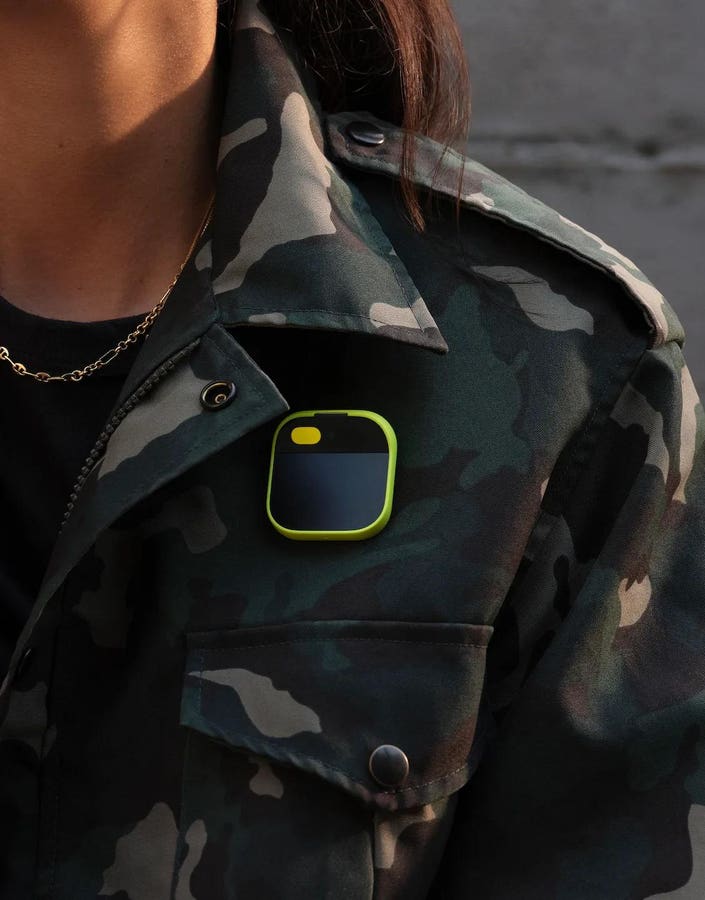Following much pomp and circumstance, San Francisco-based tech startup Humane this week officially launched its much-ballyhooed AI Pin. The device, which feels spiritually similar to a Star Trek communicator, is a wearable that a person wears on their clothing and can ask questions of its onboard assistant, as well as take pictures. There’s also a projector which projects a simple interface onto the palm of the user’s hand. According to Humane, the AI Pin costs $699 and pre-orders begin on November 16. It will start shipping sometime next year.
The company, founded by ex-Apple engineers in husband-and-wife duo Imran Chaudhri and Bethany Bongiorno, showed off the device and its capabilities in a video released on Thursday morning. Humane invited a small gaggle of reporters to an event at its headquarters; Inverse’s Ian Carlos Campbell was one of them, and he filed a good story with his initial impressions of Humane’s very fancy, souped-up clothespin.
Last night, I posted somewhat of a screed to X/Twitter wherein I criticize the lack of transparency regarding the AI Pin’s accessibility attributes. In my mind, it’s a colossal failure not merely on the part of Humane—Chaudhri romantically says in the video the company is “building not for today but for tomorrow”—but especially on the part of editors and reporters. It isn’t the fault of any people in particular, but it’s collective nonchalantness and absentmindedness that really rankles me.
Considering the aforementioned pomp and circumstance, it doesn’t take an astrophysicist to glean Humane is pitching the AI Pin as something that should replace the smartphone. It’s also fairly obvious to glean that, being a company started and staffed by former Apple employees, work on the device has been shrouded in secrecy. If the AI Pin had pores, the Apple heritage would be oozing from them. But given the conceit of this thing purportedly being “the next big thing,” it stands to reason to wonder how accessible and inclusive it is. Even a company as tight-lipped as Apple, I was told plainly after WWDC this year that Vision Pro was built with accessibility in mind. Details were (and remain) scant, but the point is the company purposely allayed any fears I had—as a journalist and, more importantly, as a lifelong disabled person—that the harbinger of spatial computing indeed would have accessibility baked in from day one. By contrast, the due diligence I’ve done in digging for any crumb of accessibility information on the AI Pin has proven fruitless.
Which leads me to the journalistic side of the problems here.
In all the coverage I’ve seen on Humane and its AI Pin, not once have I noticed anyone bring up accessibility. It’s unsurprising, but nonetheless disheartening. Tech writers need not be an expert in accessibility and assistive technologies as I am simply to ask whether the AI Pin will be accessible to the disability community. So many editors, especially in the nascent days of my career, turned down pitches of mine in large part because they wrongly presumed covering accessibility was too niche and esoteric. It wasn’t what a broader, mainstream readership would be interested in. More tellingly, they also said they were reticent to cover accessibility because they didn’t know anything about it. Which, in hindsight, was a perplexing admission because… that’s the point of my work because disability is a defining factor of my lived experiences.
Again, though, a journalist with any shred of empathy needn’t be accessibility’s Einstein to at least ask questions. As I tweeted last night, there are questions aplenty. What happens if you have a speech delay like a stutter and the assistant can’t understand you? What happens if you can’t push the button or clip the Pin to your clothing? What if you can’t open your palms for the projector UI? Does said UI support text size or contrast or screen reader options? These questions are vital to the AI Pin’s usability story, yet no one has the prescience to ask them.
Should disabled people assume the AI Pin is only for fully-abled people?
There’s twisted irony in the fact a company calls itself humane and speaks of highfalutin ideas like the technology of tomorrow and enhancing humanity. Do disabled people just not fit their view of humanity?
I should concede it’s early days for the AI Pin and, like Apple and Vision Pro, perhaps Humane is committed to making the device accessible. Still, it’s irksome to spout this grandiose vision of the future without at least acknowledging not all of humanity uses tech in the same ways.
On the journalism side, the complete dearth of questioning regarding accessibility is yet another illustration of just how far journalism has to go in their DEI initiatives. It’s not an either/or scenario; disabled people aren’t asking newsrooms to choose other aspects of social justice reporting over others. It’s about empathy and inclusiveness. Disabled people deserve to have their voices heard just like any other underrepresented group, especially considering we make up the largest marginalized group on the planet. So many institutions fancy themselves staunch DEI advocates when, in reality, their actions staunchly leave out disabled people. The whole message rings hollow and feels disingenuous.
The media industry’s priorities, and ostensible lack of care in this realm of social justice reporting, become soberingly crystal clear when you see an outlet hiring a full-time Taylor Swift reporter. It’s certainly a choice.
Whether the AI Pin sinks or swims remains to be seen. One thing is for sure right now: Accessibility will have a hand in that either way.
For now, the AI Pin’s accessibility story is frustratingly untold.
Read the full article here





